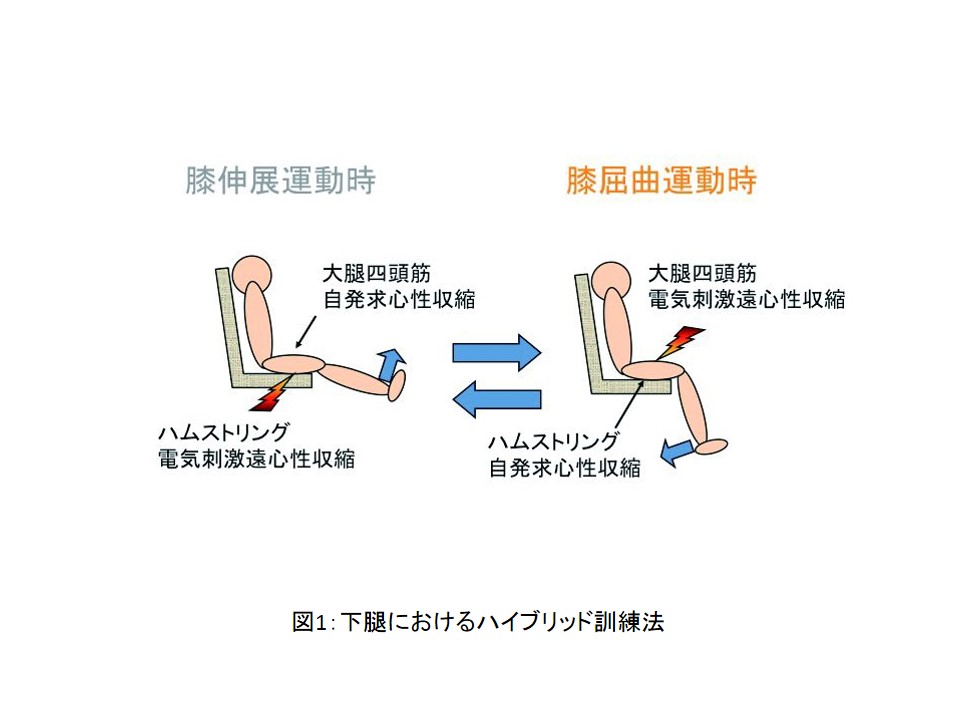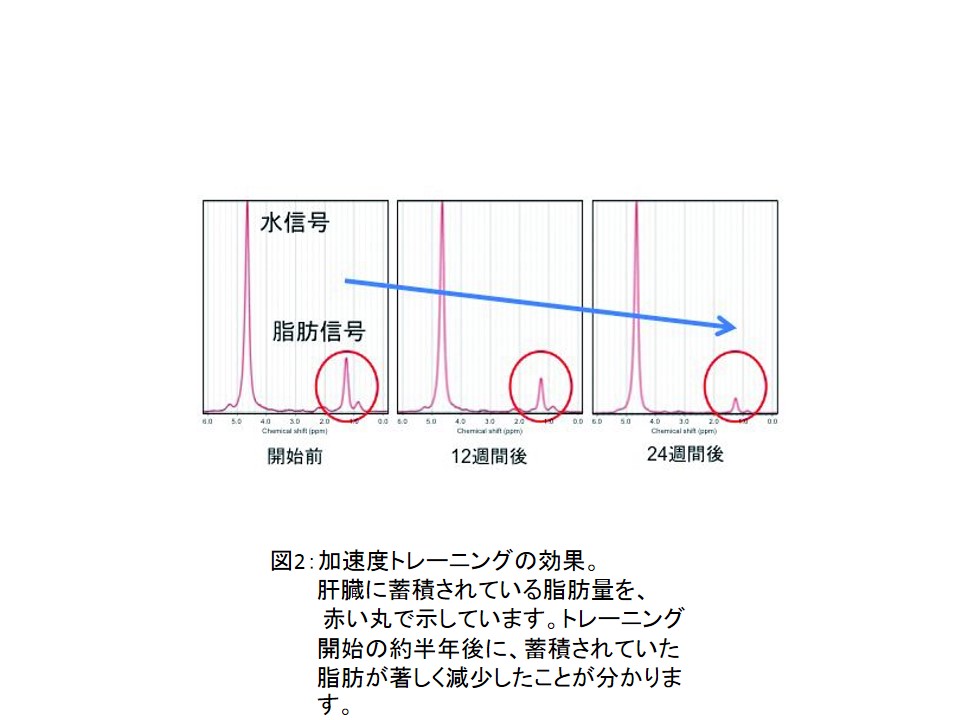キーワード: 肥満、生活習慣病、動物モデル、運動実践、分子生物学
http://www.hosp.tsukuba.ac.jp/outpatient/outpatient/special/sports.html
 日本では、食べ過ぎと運動不足による肥満が増えており、現在、国民の約30%がBMI値25を超えています※1。肥満は、さまざまな生活習慣病につながるため、肥満を予防・改善する食事療法と運動療法を日々の生活に取り入れることが重要です。本リサーチユニットでは、運動療法に焦点をあて、種々の運動療法のデータを医学の視点から解析することによって運動療法の有効性を示し、肥満と生活習慣病の予防・治療を目指しています。
日本では、食べ過ぎと運動不足による肥満が増えており、現在、国民の約30%がBMI値25を超えています※1。肥満は、さまざまな生活習慣病につながるため、肥満を予防・改善する食事療法と運動療法を日々の生活に取り入れることが重要です。本リサーチユニットでは、運動療法に焦点をあて、種々の運動療法のデータを医学の視点から解析することによって運動療法の有効性を示し、肥満と生活習慣病の予防・治療を目指しています。
体育学と医学がタッグを組んだ新しい学問分野「スポトロジー」
生活習慣病に対する食事療法は充実してきましたが、運動療法に関しては、科学的根拠に基づいたものがまだ十分にない状態です。「スポトロジー」とは、体育学と医学がタッグを組んで科学的根拠に基づいた運動療法を開発し、生活習慣病の予防・治療や健康増進を目指す新しい学問です。私たちは、筑波大学の体育系で実施されてきた運動療法に関するデータを用いて、運動することで脂肪代謝・肝臓代謝などがどのくらい改善するのかを分子レベルで解析しています。そして、その結果をもとに新しい運動療法をデザインし、新しい運動プログラムを実証していきます。

骨格筋を鍛えて、肝臓の脂肪を落とす
私たちは、脂肪肝※2の一タイプである非アルコール性脂肪性肝疾患(NAFLD)※3に対する新たな運動療法として、(1)自発収縮と電気刺激を組み合わせたハイブリッドトレーニング(図1)と、(2)大きなプレートの上に乗って全身の筋肉を振動させる加速度トレーニングを導入しました。これらは、骨格筋を鍛えることを目的としたレジスタンス運動(無酸素運動)なので、体重はあまり変わりませんが、トレーニング開始後わずか半年で、NAFLDの患者さんの肝臓の脂肪がみるみる落ちていき(図2)、肝臓の障害も軽減できました。このトレーニングは、腰や膝が悪い患者さんでも、簡単に無理なく続けることができます。現在は、骨格筋トレーニングによって肝臓の脂肪が落ちる分子メカニズム解明にも取り組んでいます。
将来的には、これら研究成果を積み重ねて、科学的根拠に基づいた運動療法を確立し、生活習慣病の予防・治療に貢献したいと考えています。
*1: BMI(体格指数、Body Mass Index の略)は、肥満の程度をはかる指数で、計算式は「体重(kg)÷(身長(m)× 身長(m))」
です。BMI 値25 以上の人が「肥満」と判定されます。
*2:肝臓に脂肪が過剰に蓄積した状態。肥満や飲酒が主な原因であると言われています。
*3:Non-Alcoholic Fatty Liver Disease の略

社会への貢献・実績
● 医学と体育学の科学的視点から研究成果の解析を行うことにより、運動療法に関する高いエビデンスを創出
● 次代を先取りするスポーツ医学の情報発信拠点を構築することで、新しい教育および研究の両者を発展
● 研究成果は、学会発表や論文発表の他に、国の研究班や診療ガイドライン作成のための委員会等を通じて、「運動実践」の有用性と「スポーツ医学」の重要性について、国民へ情報発信
(取材:平成25年9月30日)
Preventing and Treating Diseases with Evidence-based Exercise Therapy
Unit members : Isobe, Tomonori Okamoto Yoshikazu Sekido Mitsuru Miyakawa, Shumpei Mizokami, Yuji Maeda, Seiji Ohmori, Hajime Bukawa Hiroki Yanagawa, Toru Suzuki, Hideo Warabi, Eiji
Key words: obesity, lifestyle-related diseases, animal models, exercise, molecular biology
In Japan, the incidence of obesity is increasing due to excessive food consumption and insufficient physical activity. The BMI*1 now exceeds 25 in approximately 30% of the total population. As obesity  leads to various lifestyle-related diseases, it is important to adopt diet and exercise therapy approaches to prevent obesity and improve the health status. Focusing on exercise therapy, this research unit aims to demonstrate its usefulness by analyzing data from a medical viewpoint, and prevent and treat obesity and lifestyle-related diseases.
leads to various lifestyle-related diseases, it is important to adopt diet and exercise therapy approaches to prevent obesity and improve the health status. Focusing on exercise therapy, this research unit aims to demonstrate its usefulness by analyzing data from a medical viewpoint, and prevent and treat obesity and lifestyle-related diseases.
“Sportology” as a New Field of Study Combining Athletics and Medicine
While diet therapy for lifestyle-related diseases has been promoted, evidence-based exercise therapy for such a purpose has not yet been fully established. The term “sportology” refers to a new study area combining athletics and medicine to develop evidence-based exercise therapy methods, in order to improve health by preventing and treating lifestyle-related diseases. We collect data through exercise therapy performed in the Faculty of Health and Sport Sciences of University of Tsukuba, and analyze them using molecular approaches to clarify mechanisms by which fat and liver metabolism improves through exercise. Based on the results of such analysis, we design new exercise therapies, and examine the effects of new exercise programs.
Preventing Fatty Liver by Strengthening Skeletal Muscles
As a new exercise therapy approach for a type of fatty liver*2, NAFLD*3, we have adopted 2 training methods: 1) hybrid training focusing on a combination between spontaneous contraction and electrical stimulation (Figure 1); and 2) acceleration training by vibrating systemic muscles on a large plate. As these training methods are based on resistance (anaerobic) exercise to strengthen skeletal muscles, they do not markedly change the body weight; however, the amount of liver fat decreased in only 6 months after the initiation of training in NAFLD patients (Figure 2), alleviating liver dysfunction. It is easy even for patients with low back and knee problems to continuously perform these forms of training. Currently, we are also analyzing molecular mechanisms by which skeletal muscle training reduces the amount of liver fat.
We aim to establish evidence-based exercise therapy methods by accumulating the outcomes of these studies, and contribute to the prevention and treatment of lifestyle-related diseases in the future.

Figure 1: Hybrid Training for Lower-limb Muscles

Figure 2 : Effects of Acceleration Training Values marked with a red circle represent the amount of fat in the liver, which markedly decreased in 6 months after the initiation of training.
*1: The BMI (body mass index) is an index representing the severity of obesity; calculation formula: body weight (kg) / height (m) × height (m); those with a BMI of 25 or over are considered “obese”.
*2: A condition with excess fat in the liver reportedly due to obesity or alcohol drinking.
*3: Non-alcoholic fatty liver disease
Social contributions and achievements
● Organizing a base for sport medicine as a next-generation study area to promote new education and research
● Providing people with information to develop an understanding of the effectiveness of exercise and importance of sport medicine through research groups and committees for the development of treatment guidelines, in addition to presentations at academic meetings and publication in scientific journals.
